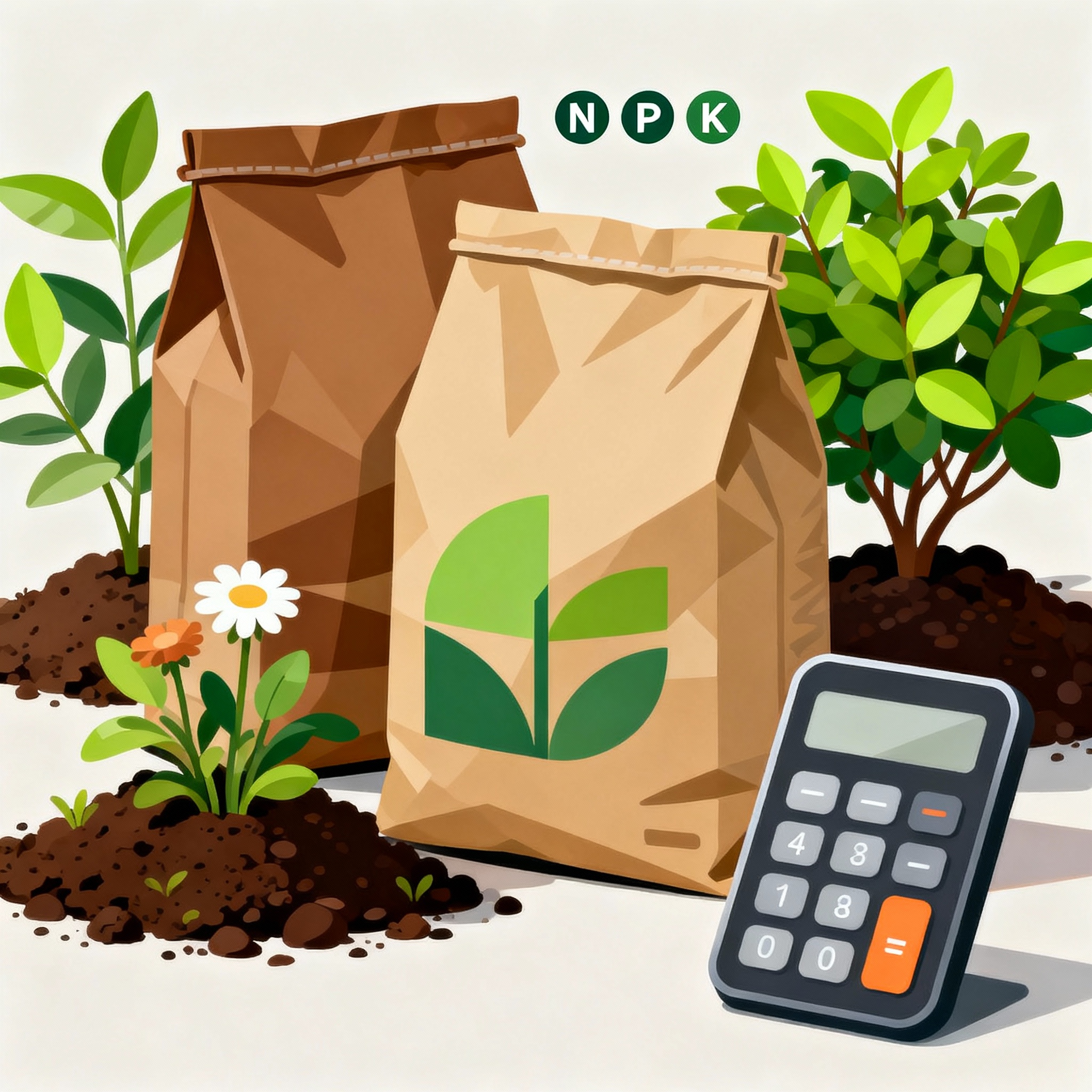NPK Application Calculator
Convert Between Fertilizer Grades
Understanding NPK Numbers
🌿 Nitrogen (N)
Role: Promotes leafy green growth and chlorophyll production
Signs of deficiency: Yellowing leaves, stunted growth
Best for: Lawns, leafy vegetables, foliage plants
🌸 Phosphorus (P)
Role: Supports root development, flowering, and fruiting
Signs of deficiency: Purple leaves, poor root growth
Best for: Flowering plants, root vegetables, new plantings
🍎 Potassium (K)
Role: Strengthens disease resistance and overall plant health
Signs of deficiency: Brown leaf edges, weak stems
Best for: Fruiting plants, drought tolerance, winter hardiness
Common Fertilizer Grades & Uses
🌱 Balanced Fertilizers
- 10-10-10: All-purpose for general use
- 20-20-20: Concentrated balanced formula
- 5-5-5: Gentle organic option
🏞️ Lawn Fertilizers
- 30-0-4: High nitrogen for rapid green-up
- 20-5-10: Balanced lawn formula
- 15-0-15: Summer stress formula
🌺 Flowering & Fruiting
- 5-10-10: Promotes blooms and fruits
- 0-20-20: Bloom booster
- 10-52-10: Super phosphate for flowering
🌿 Vegetable Gardens
- 10-10-10: General vegetable garden
- 5-10-10: Tomatoes and peppers
- 15-15-15: Heavy feeders
⚠️ Safety & Application Tips
- Always follow package instructions for application rates
- Water thoroughly after applying fertilizer
- Avoid over-fertilization – more is not always better
- Don’t apply before heavy rain (runoff risk)
- Keep fertilizer away from water sources
- Store in a cool, dry place away from children and pets
- Get a soil test before major applications
Application Timing
🌸 Spring (March-May)
Apply high-nitrogen fertilizer to lawns and early vegetables. Start slow-release formulas for annual beds.
☀️ Summer (June-August)
Use balanced or lower-nitrogen formulas. Focus on phosphorus for flowering plants and potassium for stress tolerance.
🍂 Fall (September-November)
Apply winterizer formulas (high potassium) to lawns. Reduce nitrogen to avoid late-season growth.
❄️ Winter (December-February)
Generally avoid fertilizing. Focus on soil amendments and organic matter instead.
Fertilizer Calculator User Guide
What It Does:
This calculator helps you determine exact fertilizer application rates based on NPK grades, converts between different fertilizer grades, and provides comprehensive fertilizer guidance for optimal plant nutrition.
How to Use:
🧮 NPK Calculator
Calculate how much fertilizer to apply based on your lawn or garden needs.
- Enter Fertilizer Grade (N-P-K):
- N (Nitrogen) – First number (0-100)
- P (Phosphorus) – Second number (0-100)
- K (Potassium) – Third number (0-100)
- Example: For 10-10-10 fertilizer, enter 10, 10, 10
- Specify Area to Cover:
- Enter total area size
- Choose unit: Square Feet, Square Meters, or Acres
- Set Nitrogen Requirement:
- Enter pounds of nitrogen needed per 1000 sq ft
- Recommendations:
- Lawns: 0.5-1 lb
- Vegetables: 2-4 lbs
- Flowers: 1-2 lbs
- Check soil test results for precise needs
- Calculate:
- Click “Calculate” button
- Results show:
- Total fertilizer needed (lbs)
- Application rate per 1000 sq ft
- Actual N, P, K nutrients provided
- Follow Application Tips:
- Use spreader for even distribution
- Water immediately after application
- Review safety guidelines
🔄 Convert Grades
Convert between different fertilizer grades while maintaining nutrient levels.
- Enter Current Fertilizer:
- Input current NPK grade (e.g., 20-10-10)
- Enter amount you have (in lbs)
- Enter Target Fertilizer:
- Input new NPK grade you want to use (e.g., 10-10-10)
- Convert:
- Click “Convert” button
- Calculator shows:
- Amount of target fertilizer needed
- Nutrient comparison (N, P, K differences)
- Adjustment recommendations
- Review Conversion Notes:
- Calculation based on nitrogen matching
- Phosphorus and potassium differences highlighted
- Adjust if targeting specific P or K levels
📖 Fertilizer Guide
Comprehensive reference for understanding fertilizers.
What’s Included:
- Understanding NPK Numbers:
- Nitrogen (N) – Leafy growth, chlorophyll
- Phosphorus (P) – Root development, flowering
- Potassium (K) – Disease resistance, overall health
- Common Fertilizer Grades & Uses:
- Balanced fertilizers (10-10-10, 20-20-20)
- Lawn formulas (30-0-4, 20-5-10)
- Flowering boosters (5-10-10, 0-20-20)
- Vegetable garden options
- Application Timing:
- Spring: High nitrogen for growth
- Summer: Balanced or lower nitrogen
- Fall: High potassium winterizers
- Winter: Avoid fertilizing
- Safety Guidelines:
- Proper application techniques
- Storage recommendations
- Environmental precautions
Quick Tips:
✅ Always soil test first for accurate nutrient needs
✅ Water after applying to prevent burn and activate nutrients
✅ Don’t over-fertilize – more isn’t better
✅ Match fertilizer to plant type (lawn vs. garden vs. flowers)
✅ Apply evenly using a spreader for consistent coverage
Pro Tip: Start with lower rates and increase if needed. Over-fertilization can damage plants, waste money, and harm the environment through runoff.

Angelina Everly leads the editorial desk at Live Green Gardens, blending practical plant care, hands-on product testing, and approachable outdoor styling. She focuses on step-by-step how-tos, buyer’s guides, and small-space makeovers that work in real life and real budgets. When she’s not comparing pruning shears or setting up a drip kit, you’ll find her creating cozy corners with planters, solar lights, and pollinator-friendly picks—always with clear pros/cons and safety notes so you can buy once and garden happy.

